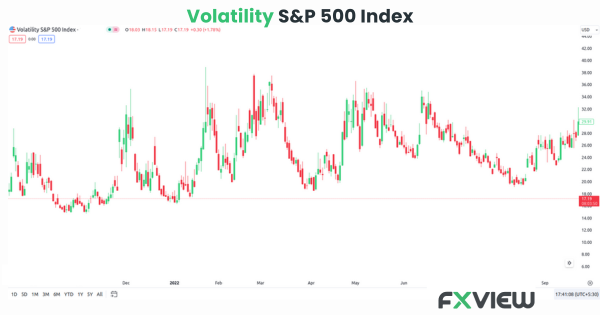
Trading the Volatility Index: A Comprehensive Guide
The forex market, much like the ocean, has its calm days and its stormy ones. And for those who are trying to navigate the unpredictable waters of the financial world, the Volatility Index, or VIX, can act as the financial world’s barometer. In this guide, we’re delving into the depths of the volatility index, exploring the benefits of the trading volatility index, uncovering its complexities, and showcasing how it can be a trader’s useful companion in the unpredictable world of trading.

Let’s understand the Trading Volatility Index (VIX)
- The VIX, known as the “fear index,” gauges the market’s anticipation of future volatility.
- It provides insight into how the market perceives risks for the next 30 days.
- Trading the VIX is a tool for diversifying investments and managing portfolios.
- Understanding how to trade the VIX can give traders an edge in handling market downturns or capitalizing on volatility.
- The VIX is calculated from S&P 500 index options’ live price data.
- A rising VIX suggests expected higher price fluctuations, while a falling VIX indicates anticipated stability.
What are the advantages of trading the Volatility Index?
The advantages of trading volatility index include:
- Portfolio Diversification: Trading volatility index allows investors to diversify their portfolios beyond traditional stocks and bonds, providing a hedge against market volatility.
- Risk Management: The VIX can act as an indicator of potential market turbulence, helping traders manage risk by adjusting their positions or implementing hedging strategies.
- Profit Potential: Volatile markets can present trading opportunities, and skilled VIX traders can profit from price movements in this index.
- Liquidity: The VIX market generally offers good liquidity, making it accessible for traders of various sizes.
- Informational Value: Monitoring the VIX provides insights into market sentiment and expectations, aiding traders in making informed decisions.
- Hedging: Investors can use VIX products to hedge against potential losses in their equity portfolios during market downturns.
- Speculation: Traders can speculate on the direction of market volatility, potentially profiting from VIX futures, options, or exchange-traded products.
Engaging in VIX Trading and its calculation
How to trade the VIX” is often a burning question among new traders. The VIX isn’t traded directly. Instead, traders can use VIX futures, options, and ETFs. Using these tools allows you to make speculations about how the VIX may change in the future, all without having to purchase the index directly.
As for how the VIX is calculated, it’s a tad complex but bear with me. It’s based on the prices of options on the S&P 500 Index. The VIX calculation estimates expected volatility by averaging the weighted prices of these options over a range of strike prices.
What implications arise when trading Volatility Index?
Imagine the weather report predicting a storm; you’d naturally expect waves to get choppier. When the VIX goes up, it may suggest that traders expect the market to make bigger moves – whether upwards or downwards – over the next 30 days. It’s often seen during uncertain times when traders are bracing for potential storms in the financial seas.
What should traders infer when the VIX takes a dip?
On the flip side, a falling VIX may suggest traders expect calmer waters ahead. The market sentiment is generally bullish, with traders anticipating fewer fluctuations. Imagine it as the peace that follows a storm.
What strategies can you employ to trade the VIX effectively?
Trading the VIX requires a strategic approach. Take some time to get acquainted with VIX-related products like futures and options. These financial tools may be used like a safety net, guarding against possible market declines. However, as with all trades, there’s no surefire win. Understanding the art of trading the VIX involves staying in the loop, keeping an eye on market trends, and adapting your strategies as needed.
How does trading in the volatility index affect the stock market?
The VIX and stock prices often move in opposite directions. When the VIX rises (indicating expected volatility), stock prices might fall due to heightened uncertainty. Conversely, when the VIX drops, it’s often accompanied by a rising stock market, with traders feeling confident and optimistic.
Key Takeaways
- The Volatility Index (VIX) is a crucial tool for assessing market expectations of future volatility.
- The trading in volatility index allows diversification and effective risk management in the financial markets.
- The VIX is calculated from S&P 500 index options, with rising values indicating expected volatility and falling values suggesting stability.
- Traders can engage in VIX trading through futures, options, and ETFs, providing ways to speculate on market volatility without directly purchasing the index.
- Strategies for trading the VIX require adaptation and staying informed about market trends.
- The VIX and stock prices often move inversely, with a rising VIX signaling potential market declines and a falling VIX reflecting optimism.
- Understanding the trading volatility index is essential for navigating the unpredictable waters of financial trading and making informed decisions in turbulent markets.
Conclusion
Trading in the Volatility Index (VIX) serves as a valuable tool for traders in navigating unpredictable financial markets. Whether it’s anticipating storms or enjoying calmer seas, understanding the VIX’s role in measuring market volatility is essential. By incorporating VIX-related strategies, understanding the trading volatility index, and staying attuned to market trends, traders can better navigate the complexities of the trading realm, ensuring their financial journeys find favorable winds.
Disclaimer: The information contained in this article is provided for educational and informational purposes only and it is not intended to be, nor does it constitute financial, investment or trading advice. You should not make any financial, investment or trading decision based on the information provided in this article without performing your own research or seeking advice from an independent advisor.



